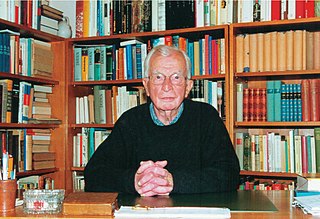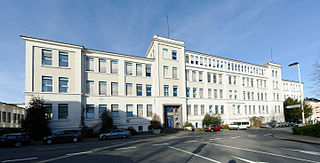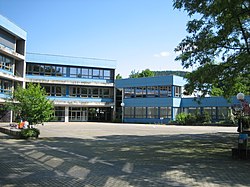
Gymnasium is a term in various European languages for a secondary school that prepares students for higher education at a university. It is comparable to the US English term preparatory high school or the British term grammar school. Before the 20th century, the gymnasium system was a widespread feature of educational systems throughout many European countries.

Education in Germany is primarily the responsibility of individual German states, with the federal government only playing a minor role.

Taunton High School is located within a large, three-floor, interconnected, multi-block complex in the eastern section of Taunton, Massachusetts, United States. It is an urban public high school with an estimated average student enrollment of 3,000 students. It offers many student-oriented services, specialty academic programs, extra-curricular clubs, various after-school programs and a wide array of scholastic sports. Taunton High School is one of the largest high schools in New England, and is the 4th largest in Massachusetts, behind Brockton, Lowell, and New Bedford.

A Hauptschule is a secondary school in Germany, starting after four years of elementary schooling (Grundschule), which offers Lower Secondary Education according to the International Standard Classification of Education. Any student who attends a German elementary school can go to a Hauptschule or Gesamtschule, while students who want to attend a Realschule or Gymnasium need to have good marks in order to do so. The students spend five to six years at the Hauptschule, from 5th to 9th grade. They finish around age 15 to 17.

Gymnasium, in the German education system, is the most advanced and highest of the three types of German secondary schools, the others being Hauptschule (lowest) and Realschule (middle). Gymnasium strongly emphasizes academic learning, comparable to the British grammar school system or with prep schools in the United States. A student attending Gymnasium is called a Gymnasiast. In 2009/10 there were 3,094 gymnasia in Germany, with c. 2,475,000 students, resulting in an average student number of 800 students per school.

Antwerp International School (AIS) is a private, international, co-educational preschool, prekindergarten, kindergarten, primary, and secondary school located in Antwerp, Belgium. Founded in 1967, the school hosts approximately 400 students and 90 staff members from at least 35 countries. AIS offers the entire continuum of the International Baccalaureate, which includes the Primary Years Programme (PYP), the Middle Years Programme (MYP) and the Diploma Programme (DP). The first senior class of AIS graduated in 1971, and the school celebrated its 50th anniversary in 2017.
Berufsoberschule is an optional part of the German education system, and is an additional way to be allowed at university for students who didn't get an Abitur at a Gymnasium.

Schramberg is a town in the district of Rottweil, in Baden-Württemberg, Germany. It is situated in the eastern Black Forest, 25 km northwest of Rottweil. With all of its districts, it has about 22,000 inhabitants.
A Wirtschaftsgymnasium is a kind of school in Germany. Unlike the German Gymnasium, which spans grades (years) 5 to 13, the Wirtschaftsgymnasium has only the top three grades (Oberstufe) and specializes in teaching business-related topics beside the normal subjects in the Gymnasium.
Dakota Prairie High School is part of a school district that covers a portion of Nelson County, North Dakota. It includes the towns of McVille, Michigan City, Tolna, Aneta, Pekin, Kloten, Dahlen, Hamar, Niagera, and Petersburg. There are 132 students currently at Dakota Prairie High School. Dakota Prairie High School is considered a "Class B" school in North Dakota.

Robert Ditter was principal of the Gymnasium Schramberg from 1964 to 1988. He was also chief editor of "D'Kräz", a journal for local history in Schramberg.

Lauterbach is a village and municipality in the district of Rottweil in Baden-Württemberg. Lauterbach is located in the Black Forest near Schramberg, and is known as a tourist resort.

The Gisela-Gymnasium München is a secondary school in Munich, Germany and belongs to the mathematical-scientific category of gymnasia but also has a modern languages branch. The school is named after its patron, the Archduchess Gisela of Austria who resided in the nearby Leopoldschlößchen with her family during her time in the city and played a significant role in local social and political events of the time.
The British International School of Jeddah is an international co-educational school established in 1977 in Jeddah, Saudi Arabia.

Fremont High School is a public high school located in Fremont, Indiana, United States. Fremont High School is the high school for the Fremont Community Schools Independent School District

Gymnasium Petrinum is a state-funded secondary school and the oldest Gymnasium in the German town of Dorsten, North Rhine-Westphalia.

The Gymnasium Schwertstraße in Solingen, North Rhine-Westphalia, Germany was established on 15 October 1841 as the Höhere Bürgerschule, and is the oldest and most traditional of the four gymnasiums in the city.

Lycée Français Marie Curie de Zurich (LFZ), German: französisches Gymnasium) is a French international school located in the municipality of Dübendorf, with more than 1,145 students from reception to year 13.

The Hohenstaufen-Gymnasium is a bilingual Gymnasium in Göppingen, Germany.

The Ernestine Gymnasium is a humanistic and modern gymnasium in Gotha, Germany, the successor of the Illustrious Gymnasium, founded in 1524, which in 1853 was merged with the recently founded Real-Gymnasium Ernestinum, named in honour of Ernest I, Duke of Saxe-Coburg and Gotha. The merged school continued to be known as the Ernestinum. Until 1947, when it was closed, it was considered the oldest gymnasium in the German-speaking world. It was re-founded in 1991, shortly after German reunification.

















